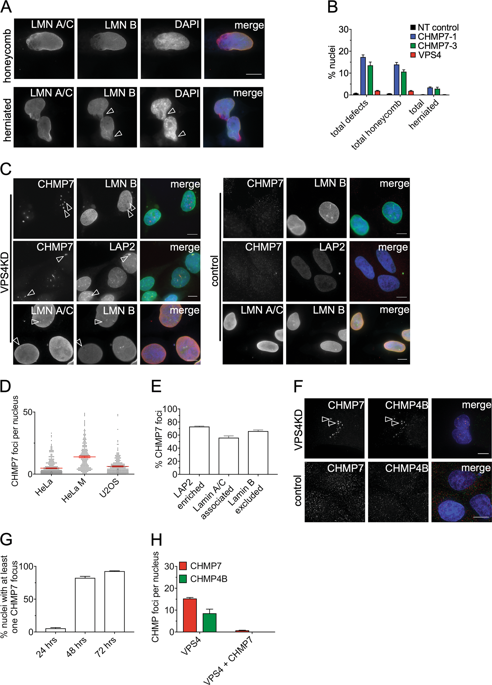Oncogenesis ( IF 6.2 ) Pub Date : 2019-04-15 , DOI: 10.1038/s41389-019-0136-0 Jessica Willan , Alexa J. Cleasby , Neftali Flores-Rodriguez , Flavia Stefani , Cinzia Rinaldo , Alessandra Pisciottani , Emma Grant , Philip Woodman , Helen E. Bryant , Barbara Ciani

|
Micronuclei represent the cellular attempt to compartmentalize DNA to maintain genomic integrity threatened by mitotic errors and genotoxic events. Some micronuclei show aberrant nuclear envelopes (NEs) that collapse, generating damaged DNA that can promote complex genome alterations. However, ruptured micronuclei also provide a pool of cytosolic DNA that can stimulate antitumor immunity, revealing the complexity of micronuclear impact on tumor progression. The ESCRT-III (Endosomal Sorting Complex Required for Transport-III) complex ensures NE reseals during late mitosis and is repaired in interphase. Therefore, ESCRT-III activity maybe crucial for maintaining the integrity of other genomic structures enclosed by a NE. ESCRT-III activity at the NE is coordinated by the subunit CHMP7. We show that CHMP7 and ESCRT-III protect against the genomic instability associated with micronuclei formation. Loss of ESCRT-III activity increases the population of micronuclei with ruptured NEs, revealing that its NE repair activity is also necessary to maintain micronuclei integrity. Surprisingly, aberrant accumulation of ESCRT-III are found at the envelope of most acentric collapsed micronuclei, suggesting that ESCRT-III is not recycled efficiently from these structures. Moreover, CHMP7 depletion relieves micronuclei from the aberrant accumulations of ESCRT-III. CHMP7-depleted cells display a reduction in micronuclei containing the DNA damage marker RPA and a sensor of cytosolic DNA. Thus, ESCRT-III activity appears to protect from the consequence of genomic instability in a dichotomous fashion: ESCRT-III membrane repair activity prevents the occurrence of micronuclei with weak envelopes, but the aberrant accumulation of ESCRT-III on a subset of micronuclei appears to exacerbate DNA damage and sustain proinflammatory pathways.
中文翻译:

ESCRT-III对于微核中核膜的完整性是必不可少的,但在破裂的微核膜上产生异常会导致损坏
微核代表了细胞对DNA进行区室化以维持基因组完整性的企图,该基因组完整性受到有丝分裂错误和遗传毒性事件的威胁。一些微核显示出异常的核被膜(NEs)崩溃,产生可促进复杂基因组改变的受损DNA。然而,破裂的微核还提供了可以刺激抗肿瘤免疫力的胞质DNA池,揭示了微核对肿瘤进展的影响的复杂性。ESCRT-III(转运III所需的内体分拣复合物)复合物可确保NE在有丝分裂后期重新封闭,并在相间进行修复。因此,ESCRT-III活性对于维持NE包围的其他基因组结构的完整性可能至关重要。NE处的ESCRT-III活性由CHMP7亚基协调。我们表明,CHMP7和ESCRT-III可以防止与微核形成相关的基因组不稳定。ESCRT-III活性的丧失会增加具有破裂的NE的微核的数量,这表明其NE修复活性对于维持微核的完整性也是必不可少的。出乎意料的是,在大多数无心坍缩的微核的包膜处发现了ESCRT-III的异常积累,这表明ESCRT-III没有从这些结构中有效地回收。此外,CHMP7耗竭可减轻ESCRT-III异常积累的微核。耗尽CHMP7的细胞显示包含DNA损伤标记RPA和胞质DNA传感器的微核减少。因此,ESCRT-III活性似乎可以二分方式保护免受基因组不稳定性的影响:



























 京公网安备 11010802027423号
京公网安备 11010802027423号